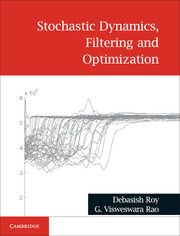Book contents
- Frontmatter
- Dedication
- Contents
- Figures
- Tables
- Preface
- Acronyms
- General Notations
- 1 Probability Theory and Random Variables
- 2 Random Variables: Conditioning, Convergence and Simulation
- 3 An Introduction to Stochastic Processes
- 4 Stochastic Calculus and Diffusion Processes
- 5 Numerical Solutions to Stochastic Differential Equations
- 6 Non-linear Stochastic Filtering and Recursive Monte Carlo Estimation
- 7 Non-linear Filters with Gain-type Additive Updates
- 8 Improved Numerical Solutions to SDEs by Change of Measures
- 9 Evolutionary Global Optimization via Change of Measures: A Martingale Route
- 10 COMBEO–A New Global Optimization Scheme By Change of Measures
- Appendix A (Chapter 1)
- Appendix B (Chapter 2)
- Appendix C (Chapter 3)
- Appendix D (Chapter 4)
- Appendix E (Chapter 5)
- Appendix F (Chapter 6)
- Appendix G (Chapter 7)
- Appendix H (Chapter 8)
- Appendix I (Chapter 9)
- References
- Bibliography
- Index
8 - Improved Numerical Solutions to SDEs by Change of Measures
Published online by Cambridge University Press: 08 February 2018
- Frontmatter
- Dedication
- Contents
- Figures
- Tables
- Preface
- Acronyms
- General Notations
- 1 Probability Theory and Random Variables
- 2 Random Variables: Conditioning, Convergence and Simulation
- 3 An Introduction to Stochastic Processes
- 4 Stochastic Calculus and Diffusion Processes
- 5 Numerical Solutions to Stochastic Differential Equations
- 6 Non-linear Stochastic Filtering and Recursive Monte Carlo Estimation
- 7 Non-linear Filters with Gain-type Additive Updates
- 8 Improved Numerical Solutions to SDEs by Change of Measures
- 9 Evolutionary Global Optimization via Change of Measures: A Martingale Route
- 10 COMBEO–A New Global Optimization Scheme By Change of Measures
- Appendix A (Chapter 1)
- Appendix B (Chapter 2)
- Appendix C (Chapter 3)
- Appendix D (Chapter 4)
- Appendix E (Chapter 5)
- Appendix F (Chapter 6)
- Appendix G (Chapter 7)
- Appendix H (Chapter 8)
- Appendix I (Chapter 9)
- References
- Bibliography
- Index
Summary
Introduction
Obtaining accurate numerical solutions to SDEs has been the focus of numerous studies owing to their relevance in many fields of engineering and science [Platen 1987, Kloeden and Platen 1992, Milstein 1995, Higham et al. 2002]. In the context of stochastic filtering (Chapters 6 and 7), it was seen that the process model is often a set of non-linear SDEs and imprecise integration techniques for these SDEs may precipitate significant numerical errors in the predicted particle locations leading to possible degradation in the filter performance. Determining solutions—strong or weak—of stochastically driven non-linear oscillators by direct numerical integration of the associated SDEs has been dealt with in Chapters 4 and 5. In particular, a universal framework for integration schemes is provided in Chapter 5 through an MC approach. There it has been shown that the Ito–Taylor expansion, which is based on an iterated Ito's formula, helps to construct integration schemes for SDEs. The possibility of developing higher order numerical integration schemes, e.g., the Milstein method [Milstein 1995], numeric–analytical techniques of LTL (locally transversal linearization) type [Roy 2000, 2001, 2004] and the stochastic Newmark method [Roy 2006], has been demonstrated along with the estimation of the order of accuracy of the higher order numerical integration schemes. However, unlike ordinary DEs, deriving higher order numerical schemes for SDEs is generally hindered by the difficulty of computing higher order MSIs. On the other hand, avoidance of the higher order MSIs, which implies retaining fewer terms in the hierarchical stochastic Taylor's approximation used to construct the integration scheme, naturally achieves relatively lower order accuracy. Most of the lower order explicit schemes (for instance, the explicit version of the EM scheme) may lose stability, for instance in the case of stiff SDEs, thus requiring impracticably low time steps to get stable solutions. Thanks to its computational expedience and ease of implementation, a lower order scheme would be ideal, were it not for a loss of integration accuracy.
- Type
- Chapter
- Information
- Stochastic Dynamics, Filtering and Optimization , pp. 467 - 506Publisher: Cambridge University PressPrint publication year: 2017

